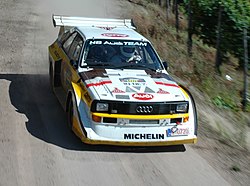
Audi Quattro - the car that changed the automotive industry
The symbol of the quattro system is the Malayan gecko. Moves through tropical forests, mainly on wet branches and slippery foliage. Good grip in such conditions is due, on the one hand, to the suction cups, and on the other hand, to the distribution of forces.
The quattro system was the result of a change in the mindset of the Audi Group in the mid-1975s. It all started with the appointment of Ferdinand Piech as a member of the board in 50. It was then that work was underway on the Audi 75 models and the SUV called Iltis, offered to various NATO armies. Especially the latter aroused interest when, despite the weak power unit with a capacity of 200 hp, the Audi 80 prototype won on snow and ice. Passenger model. The fathers of the project were: Jörg Bensinger - initiator, Ferdinand Piech - patron, leader and Walter Treser - head of the design department. The designer car was codenamed Audi, but needed a more distinctive name. The decision on its selection should have been made at the product strategy meeting. Two ideas were presented: Carat (short for Coupe All Rad Antrieb Turbo) and Quattro. Walter Treser, author of the name Quattro, found out about the second proposal and checked that there were already - one of the cheapest - perfumes of the same name. He procured one bottle of perfume, and when the name "Karat" was mentioned during the meeting, he took it out and hinted that one could not call a product intended to conquer the world nothing more than a crappy perfume for women. Thus, the Quattro name won.
Sports success
In March 1980, the car was presented to the press at the Geneva Motor Show, but the most important decision was the start in the rally. From the very beginning, designers and engineers agreed that the new car should be presented on the sports arena. Ferdinand Piech rightly noted that the success of the quattro will only ensure competition with it. Otherwise, permanent four-wheel drive would be just a technical episode. Only the 1981 World Rally Championship was able to provide a quick and direct confrontation with competitors. When collecting a rally team, they turned to Fin, Hann Mikkola and .. a woman named Michelle Mouton. In the fall of 1981, the unthinkable happened: Michel Mouton became the first woman in the history of motorsport to win the San Remo race in the World Championship. It was the best advertisement for the Quattro system. Since then, everyone was sure that "even a woman, having a car with such a drive at her disposal, can easily win."
The Quattro system also has one of the most original commercials on television. In 1986, Harald Demuth drove a red Audi 100 CS quattro (136 km) on the Pitkavuori ski jump in Kaipole, Finland. The event electrified the whole world, but no one dared to repeat the success. This record was broken only by Uwe Black on the occasion of the "25 years of quattro" anniversary. Black, driving an Audi A6 4.2 quattro in Atlas Grey, reached a height of 47 meters in nine seconds, climbing at an angle of 37,5 degrees, i.e. about 80%.
How does quattro work?
The driving force is distributed automatically and continuously. With front or rear wheel drive, 50% of the engine power is sent to each wheel. In contrast, with quattro drive, only 25% of the power is transferred to each drive wheel. Less traction means less risk of skidding, better traction and more safety when maneuvering. Thus, the all-wheel drive ensures greater traction and driving comfort even on slippery surfaces. With the distribution of torque between both axles, the changes in their load due to acceleration or weight gain are much less than in the case of rear or front-wheel drive. Thanks to this, the car accelerates much faster and copes with steep hills better.
Today, safe driving is facilitated by special sensors that recognize undesirable steering behavior and problems with maintaining a given direction of movement. They provide stability by influencing the distribution of braking forces. Thus, in combination with the traction control and traction control, maximum safety is ensured for the passengers of the Audi quattro. As a result, when driving on wet surfaces, the rear wheels take over the traction forces following the alignment of the front wheels, which have already had time to spray water (usually then the wheels lose traction).
Every driver can benefit from the knowledge Audi engineers have gained from sports racing. The all-wheel drive fitted to production cars is not much different from the system used in rally and racing cars. The Audi quattro thus guarantees excellent performance and a truly sporty driving style, while being safe at the same time.
Currently, all Audi models, from the A3 to the A8, are available in quattro versions and the system is constantly being modified. Although Audi makes no distinction between individual versions of the Quattro, six generations of the Quattro have been built since 1980:
First generation: center differential - open, manually locked with a button on the console, rear differential - open, manually locked with a button on the console, front differential - open without locking.
Second generation: center differential - Torsen T1 - type 1 (under normal clutch conditions, the system transmits torque to the wheels of the front and rear axles in a ratio of 50-50), rear differential - open, manually locked with a button on the console, front differential - open without the possibility blocking.
The third generation is used only in V8: manual transmission - Torsen T1 differential, automatic transmission - planetary gear, rear differential - Torsen T1, front differential - open without locking.
Fourth generation: center differential - Torsen T1, rear differential - open with electronic lock, front differential - open with electronic lock.
Fifth generation: center differential - Torsen type3, rear differential - open with electronic lock, front differential - open with electronic lock.
Sixth generation RS5 only: Crown-gear center Differential offering similar performance to the Torsen type3, but with a different design, the car should perform better in tougher road conditions, electronically lockable rear differential, electronically locking front differential electronic lock.
From the beginning of production to the present day, the A3 and TT models (as well as the recently introduced Q3) use a pseudo center differential - the Haldex clutch. The type of drive is determined by the location of the engine in front, transversely. Under favorable conditions, the car drives only the front axle. The back is attached.
The R8 uses a viscous coupling that constantly transmits torque to all wheels with a ratio of 85% rear, 15% front. In the event of rear wheel spin, the clutch can transfer up to 30% of torque to the front wheel.

